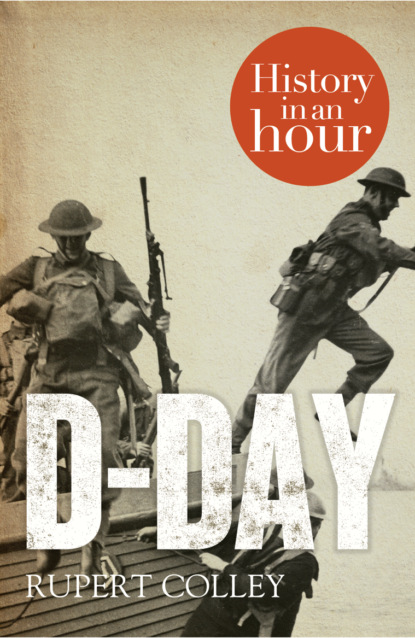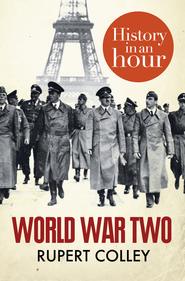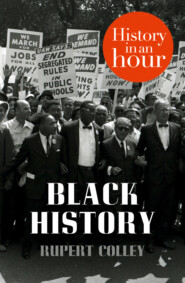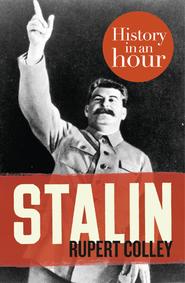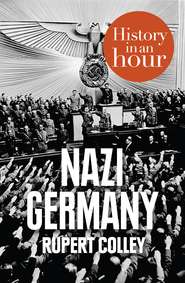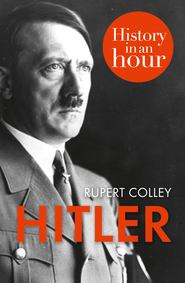По всем вопросам обращайтесь на: info@litportal.ru
(©) 2003-2024.
✖
D-Day: History in an Hour
Настройки чтения
Размер шрифта
Высота строк
Поля
D-Day: History in an Hour
Rupert Colley
Love history? Know your stuff with History in an Hour.Midnight, Tuesday 6 June 1944: the beginning of D-Day, the operation to invade Nazi-occupied Western Europe and initiate the final phase of World War II. A vast undertaking, it involved 12,000 aircraft and an amphibious assault of almost 7,000 vessels. 160,000 troops would cross the English Channel during Operation Overlord, paving the way for more than three million allied troops to enter France by the end of August 1944.Forces from the United Kingdom, the United States, Canada, the Free French and Poland all heavily participated, alongside contingents from Belgium, Greece, the Netherlands, and Norway, They capitalised on the element of surprise achieved due to bad weather and the success of Operation Bodyguard – a feat of massive deception to convince Hitler that the landings would hit Pas-de-Calais. In just over a year, the war would be won. ‘D-Day: History in an Hour’ is the story of how the largest military operation in history had been planned, practised and executed.Love history? Know your stuff with History in an Hour…
D-DAYHistory in an Hour
Rupert Colley
CONTENTS
Cover (#ua6386192-260a-59fe-b845-631036bea629)
Title Page (#u9f2e4c4e-8b32-53a2-9d12-49b4e1ee2955)
Introduction
Background
Deception
Eisenhower
The Atlantic Wall
Bombing
Training
Eve of the Invasion
6 June: D-Day (the 1,738th day of the war)
Five Beaches
The Battle of Normandy
Liberation
What Might Have Been…
Appendix 1: Key Players
Appendix 2: Timeline
Appendix 3: D-Day and Battle of Normandy Statistics (#litres_trial_promo)
Appendix 4: Normandy Cemeteries
Copyright
Got Another Hour?
About the Publisher
INTRODUCTION (#u6059ab15-139a-5a89-844a-3995b4326231)
D-Day, 6 June 1944, was a date that altered the course of history. The invasion of Occupied France by Allied forces, codenamed Operation Overlord, had been years in the planning and subject to the utmost secrecy. The Germans knew that an attack would come but when and where was the subject of much speculation for Adolf Hitler and his generals. For the operation to succeed, it was vital for the Allies to maximize the element of surprise. The Allied commanders, planning the assault, could not allow the enemy to meet the attack in strength at the very moment it was at its most vulnerable – the time it took to land troops on the beaches of Normandy. The stakes could not have been higher – the liberation of Western Europe from the occupying forces of Nazi Germany, ahead of the assault on Germany itself and, ultimately, the defeat of Hitler.
In order to trick the Germans into believing the invasion would take place elsewhere, the Allies embarked on an elaborate campaign of deception. The ruse worked and on D-Day 156,000 Allied troops managed to land along a fifty-mile stretch of Normandy coastline. It was vital, also, to maintain the deception even after D-Day to oblige Hitler into keeping much of his force back in preparation for a possible assault elsewhere.
D-Day was, for the Germans, the beginning of the end. Now the prospect of liberation from Nazi rule was within reach. The sixth of June was the day that millions of people across occupied Europe had hoped and waited for. Among them was 14-year-old Anne Frank. On 22 May 1944, Anne wrote in her diary, ‘All of Amsterdam, all of Holland, in fact the entire western coast of Europe all the way down to Spain, are talking about the invasion day and night, debating, making bets and… hoping. The suspense is rising to fever pitch.’
This, in an hour, is the epic story of D-Day.
BACKGROUND (#u6059ab15-139a-5a89-844a-3995b4326231)
D-Day initiated the end-game of what had been an unprecedented struggle for supremacy in Europe. If the Second Battle of El Alamein in 1942 had been what Winston Churchill called ‘the end of the beginning’, then D-Day was perhaps the beginning of the end.
Almost five years before D-Day, on 1 September 1939, Hitler had launched the German invasion of Poland. Two days later, Great Britain and France had declared war on Germany – and so the Second World War had begun. While German forces then struck Poland from the west, from 17 September, forces of the Soviet Union attacked from the east.
With Poland crushed between two totalitarian heavyweights, Hitler focused his attention on Scandinavia. On 9 April 1940, German forces attacked both Denmark, which capitulated within six hours, and Norway, which held out until 10 June.
On 10 May, Hitler launched the German invasion of Western Europe. By 28 May, Luxembourg, Belgium and the Netherlands had surrendered. On 10 June, Germany invaded France. On the same day, Benito Mussolini, fascist dictator of Italy, keen to share in Germany’s spoils of victory, declared war on France and Britain. British troops, sent to aid the French, were forced back to the French port of Dunkirk before being evacuated back to Britain. On 22 June, France, under its new prime minister, Philippe Pétain, surrendered. The dark years of Nazi occupation had begun.
During the summer of 1940, the Battle of Britain raged above the skies of southern England as the RAF saved Britain from the German Luftwaffe, while, soon after, Britain endured the Blitz, the aerial bombardment of its cities.
In 1941, the German juggernaut continued on its course of destruction. Greece fell, as did Yugoslavia. Then, on 22 June, Hitler launched the invasion of the Soviet Union, opening up the Eastern Front, which, over the coming four years, would experience the most brutal fighting perhaps ever seen.
The war became truly global when, on 7 December 1941, Japan attacked the American fleet anchored at Pearl Harbor, on the Hawaiian island of Oahu. Four days later, Hitler and Mussolini declared war on the USA.
The Dieppe Raid
In August 1942, Winston Churchill, Britain’s wartime prime minister, flew to Moscow and there met for the first time the Soviet leader, Joseph Stalin. Stalin had been urging Churchill to open a second front by attacking Nazi-occupied Europe from the west, thereby forcing Hitler to divert troops to the west and alleviating in part the enormous pressure the Soviet Union found itself under. Now, as Churchill prepared to meet Stalin, German forces were bearing down on the strategically and symbolically important Russian city of Stalingrad.
Churchill knew that if Germany were to defeat the Soviet Union then Hitler would be able to concentrate his whole military strength on the west. But although tentative plans for a large-scale invasion were afoot, to act too quickly, too hastily, would be foolhardy. Churchill withstood Stalin’s pressure. There would be no second front for at least another year. But, in the meantime, Churchill was able to offer a ‘reconnaissance in force’ on the French port of Dieppe, with the objective of drawing away German troops from the Eastern Front. Whether Stalin was at all appeased by this morsel of compensation, Churchill does not say.
German soldiers defending the French port of Dieppe against the Anglo-Canadian raid, 19 August 1942. (Photo: Bundesarchiv, Bild 101I-291-1213-34 / Müller, Karl / CC-BY-SA)
Thus in the early hours of 19 August 1942, the Allies launched Operation Jubilee – the raid on Dieppe sixty-five miles across from England. Two hundred and fifty-two ships crossed the Channel in a five-pronged attack. They carried tanks together with 5,000 Canadians and 1,000 British and American troops plus a handful of fighters from the French resistance. Nearing their destination, one prong ran into a German merchant convoy. A skirmish ensued. More fatally, it meant that the element of surprise had been lost – aware of what was taking place, the Germans at Dieppe were now waiting in great numbers. What followed was a disaster as the Germans unleashed a withering fire from cliff tops and port-side hotels. A Canadian war correspondent described the scene as men tried to disembark from their landing craft: the soldiers ‘plunged into about two feet of water and machine-gun bullets laced into them. Bodies piled up on the ramp.’ Neutralized by German fighters, overhead support from squadrons of RAF planes proved ineffectual. Only twenty-nine tanks managed to make it ashore where they struggled on the shingle beach, and of those only fifteen were able to advance as far as the sea wall, only to be prevented from encroaching into the town by concrete barriers.
The Dieppe Raid, which had lasted just six hours, was a costly affair – 60 per cent of ground troops were killed, wounded or taken prisoner. The operation left 1,027 dead, of whom 907 were Canadian. A further 2,340 troops were captured, and 106 aircraft shot down. An American, Lieutenant Edward V. Loustalot, earned the unenviable distinction of becoming the first US soldier killed in wartime Europe.
Despite the failure of Dieppe and the high rate of losses, important lessons were learned – that a direct assault on a well-defended harbour was not an option for any future attack; and that superiority of the air was a prerequisite. Churchill concluded that the raid had provided a ‘mine of experience’. In charge of the operation, Vice Admiral Lord Louis Mountbatten, cousin to King George VI, would later say, ‘If I had the same decision to make again, I would do as I did before… For every soldier who died at Dieppe, ten were saved on D-Day.’ Hitler too felt as if a lesson had been learned. Knowing that at some point the Allies would try again, he said, ‘We must reckon with a totally different mode of attack and in quite a different place.’
PLANNING
Casablanca Conference
Meeting in January 1943, Churchill and US president Franklin D. Roosevelt agreed that a cross-Channel invasion was a necessity, and that plans for such a venture should be initiated. But at this stage both the prime minister and the president had alternative priorities: for Churchill, the focus of the war in Europe would be centred on Italy, starting with an invasion of Sicily; while Roosevelt’s main concern was the ongoing war in the Pacific.
Rupert Colley
Love history? Know your stuff with History in an Hour.Midnight, Tuesday 6 June 1944: the beginning of D-Day, the operation to invade Nazi-occupied Western Europe and initiate the final phase of World War II. A vast undertaking, it involved 12,000 aircraft and an amphibious assault of almost 7,000 vessels. 160,000 troops would cross the English Channel during Operation Overlord, paving the way for more than three million allied troops to enter France by the end of August 1944.Forces from the United Kingdom, the United States, Canada, the Free French and Poland all heavily participated, alongside contingents from Belgium, Greece, the Netherlands, and Norway, They capitalised on the element of surprise achieved due to bad weather and the success of Operation Bodyguard – a feat of massive deception to convince Hitler that the landings would hit Pas-de-Calais. In just over a year, the war would be won. ‘D-Day: History in an Hour’ is the story of how the largest military operation in history had been planned, practised and executed.Love history? Know your stuff with History in an Hour…
D-DAYHistory in an Hour
Rupert Colley
CONTENTS
Cover (#ua6386192-260a-59fe-b845-631036bea629)
Title Page (#u9f2e4c4e-8b32-53a2-9d12-49b4e1ee2955)
Introduction
Background
Deception
Eisenhower
The Atlantic Wall
Bombing
Training
Eve of the Invasion
6 June: D-Day (the 1,738th day of the war)
Five Beaches
The Battle of Normandy
Liberation
What Might Have Been…
Appendix 1: Key Players
Appendix 2: Timeline
Appendix 3: D-Day and Battle of Normandy Statistics (#litres_trial_promo)
Appendix 4: Normandy Cemeteries
Copyright
Got Another Hour?
About the Publisher
INTRODUCTION (#u6059ab15-139a-5a89-844a-3995b4326231)
D-Day, 6 June 1944, was a date that altered the course of history. The invasion of Occupied France by Allied forces, codenamed Operation Overlord, had been years in the planning and subject to the utmost secrecy. The Germans knew that an attack would come but when and where was the subject of much speculation for Adolf Hitler and his generals. For the operation to succeed, it was vital for the Allies to maximize the element of surprise. The Allied commanders, planning the assault, could not allow the enemy to meet the attack in strength at the very moment it was at its most vulnerable – the time it took to land troops on the beaches of Normandy. The stakes could not have been higher – the liberation of Western Europe from the occupying forces of Nazi Germany, ahead of the assault on Germany itself and, ultimately, the defeat of Hitler.
In order to trick the Germans into believing the invasion would take place elsewhere, the Allies embarked on an elaborate campaign of deception. The ruse worked and on D-Day 156,000 Allied troops managed to land along a fifty-mile stretch of Normandy coastline. It was vital, also, to maintain the deception even after D-Day to oblige Hitler into keeping much of his force back in preparation for a possible assault elsewhere.
D-Day was, for the Germans, the beginning of the end. Now the prospect of liberation from Nazi rule was within reach. The sixth of June was the day that millions of people across occupied Europe had hoped and waited for. Among them was 14-year-old Anne Frank. On 22 May 1944, Anne wrote in her diary, ‘All of Amsterdam, all of Holland, in fact the entire western coast of Europe all the way down to Spain, are talking about the invasion day and night, debating, making bets and… hoping. The suspense is rising to fever pitch.’
This, in an hour, is the epic story of D-Day.
BACKGROUND (#u6059ab15-139a-5a89-844a-3995b4326231)
D-Day initiated the end-game of what had been an unprecedented struggle for supremacy in Europe. If the Second Battle of El Alamein in 1942 had been what Winston Churchill called ‘the end of the beginning’, then D-Day was perhaps the beginning of the end.
Almost five years before D-Day, on 1 September 1939, Hitler had launched the German invasion of Poland. Two days later, Great Britain and France had declared war on Germany – and so the Second World War had begun. While German forces then struck Poland from the west, from 17 September, forces of the Soviet Union attacked from the east.
With Poland crushed between two totalitarian heavyweights, Hitler focused his attention on Scandinavia. On 9 April 1940, German forces attacked both Denmark, which capitulated within six hours, and Norway, which held out until 10 June.
On 10 May, Hitler launched the German invasion of Western Europe. By 28 May, Luxembourg, Belgium and the Netherlands had surrendered. On 10 June, Germany invaded France. On the same day, Benito Mussolini, fascist dictator of Italy, keen to share in Germany’s spoils of victory, declared war on France and Britain. British troops, sent to aid the French, were forced back to the French port of Dunkirk before being evacuated back to Britain. On 22 June, France, under its new prime minister, Philippe Pétain, surrendered. The dark years of Nazi occupation had begun.
During the summer of 1940, the Battle of Britain raged above the skies of southern England as the RAF saved Britain from the German Luftwaffe, while, soon after, Britain endured the Blitz, the aerial bombardment of its cities.
In 1941, the German juggernaut continued on its course of destruction. Greece fell, as did Yugoslavia. Then, on 22 June, Hitler launched the invasion of the Soviet Union, opening up the Eastern Front, which, over the coming four years, would experience the most brutal fighting perhaps ever seen.
The war became truly global when, on 7 December 1941, Japan attacked the American fleet anchored at Pearl Harbor, on the Hawaiian island of Oahu. Four days later, Hitler and Mussolini declared war on the USA.
The Dieppe Raid
In August 1942, Winston Churchill, Britain’s wartime prime minister, flew to Moscow and there met for the first time the Soviet leader, Joseph Stalin. Stalin had been urging Churchill to open a second front by attacking Nazi-occupied Europe from the west, thereby forcing Hitler to divert troops to the west and alleviating in part the enormous pressure the Soviet Union found itself under. Now, as Churchill prepared to meet Stalin, German forces were bearing down on the strategically and symbolically important Russian city of Stalingrad.
Churchill knew that if Germany were to defeat the Soviet Union then Hitler would be able to concentrate his whole military strength on the west. But although tentative plans for a large-scale invasion were afoot, to act too quickly, too hastily, would be foolhardy. Churchill withstood Stalin’s pressure. There would be no second front for at least another year. But, in the meantime, Churchill was able to offer a ‘reconnaissance in force’ on the French port of Dieppe, with the objective of drawing away German troops from the Eastern Front. Whether Stalin was at all appeased by this morsel of compensation, Churchill does not say.
German soldiers defending the French port of Dieppe against the Anglo-Canadian raid, 19 August 1942. (Photo: Bundesarchiv, Bild 101I-291-1213-34 / Müller, Karl / CC-BY-SA)
Thus in the early hours of 19 August 1942, the Allies launched Operation Jubilee – the raid on Dieppe sixty-five miles across from England. Two hundred and fifty-two ships crossed the Channel in a five-pronged attack. They carried tanks together with 5,000 Canadians and 1,000 British and American troops plus a handful of fighters from the French resistance. Nearing their destination, one prong ran into a German merchant convoy. A skirmish ensued. More fatally, it meant that the element of surprise had been lost – aware of what was taking place, the Germans at Dieppe were now waiting in great numbers. What followed was a disaster as the Germans unleashed a withering fire from cliff tops and port-side hotels. A Canadian war correspondent described the scene as men tried to disembark from their landing craft: the soldiers ‘plunged into about two feet of water and machine-gun bullets laced into them. Bodies piled up on the ramp.’ Neutralized by German fighters, overhead support from squadrons of RAF planes proved ineffectual. Only twenty-nine tanks managed to make it ashore where they struggled on the shingle beach, and of those only fifteen were able to advance as far as the sea wall, only to be prevented from encroaching into the town by concrete barriers.
The Dieppe Raid, which had lasted just six hours, was a costly affair – 60 per cent of ground troops were killed, wounded or taken prisoner. The operation left 1,027 dead, of whom 907 were Canadian. A further 2,340 troops were captured, and 106 aircraft shot down. An American, Lieutenant Edward V. Loustalot, earned the unenviable distinction of becoming the first US soldier killed in wartime Europe.
Despite the failure of Dieppe and the high rate of losses, important lessons were learned – that a direct assault on a well-defended harbour was not an option for any future attack; and that superiority of the air was a prerequisite. Churchill concluded that the raid had provided a ‘mine of experience’. In charge of the operation, Vice Admiral Lord Louis Mountbatten, cousin to King George VI, would later say, ‘If I had the same decision to make again, I would do as I did before… For every soldier who died at Dieppe, ten were saved on D-Day.’ Hitler too felt as if a lesson had been learned. Knowing that at some point the Allies would try again, he said, ‘We must reckon with a totally different mode of attack and in quite a different place.’
PLANNING
Casablanca Conference
Meeting in January 1943, Churchill and US president Franklin D. Roosevelt agreed that a cross-Channel invasion was a necessity, and that plans for such a venture should be initiated. But at this stage both the prime minister and the president had alternative priorities: for Churchill, the focus of the war in Europe would be centred on Italy, starting with an invasion of Sicily; while Roosevelt’s main concern was the ongoing war in the Pacific.





